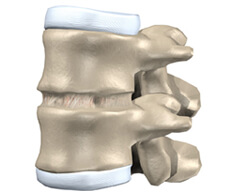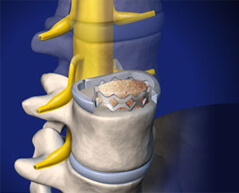Anterior Lumbar Interbody Fusion (ALIF)
Spinal fusion is a surgical procedure used to correct problems with the small bones in the spine (vertebrae). It is essentially a "welding" process. The basic idea is to fuse together the painful vertebrae so that they heal into a single, solid bone.
.jpg) An interbody fusion involves removing the intervertebral disk. When the disk space has been cleared out, a metal, plastic, or bone spacer is implanted between the two adjoining vertebrae. These spacers, or "cages", usually contain bone graft material. This promotes bone healing and facilitates the fusion. After the cage is inserted, surgeons often use metal screws, plates, and rods to further stabilize the spine.
An interbody fusion involves removing the intervertebral disk. When the disk space has been cleared out, a metal, plastic, or bone spacer is implanted between the two adjoining vertebrae. These spacers, or "cages", usually contain bone graft material. This promotes bone healing and facilitates the fusion. After the cage is inserted, surgeons often use metal screws, plates, and rods to further stabilize the spine.
An interbody fusion can be performed using a variety of different approaches. In an anterior lumbar interbody fusion (ALIF), the procedure is performed from the front. With this approach, the organs and blood vessels must be moved to the side. This allows your surgeon to access the spine without moving the nerves.
Doctor Cloward first performed an anterior lumbar interbody fusion (ALIF) surgery in the 1950s for treatment of lower back pain for degenerative spine conditions. The Cloward procedure did not gain immediate favor because of fairly high nonunion rates (30-40%).
The ALIF approach is advantageous in that, unlike the PLIF and posterolateral gutter approaches, both the back muscles and nerves remain undisturbed. Another advantage is that placing the bone graft in the front of the spine places it in compression, and bone in compression tends to fuse better. Lastly, a much larger implant can be inserted through an anterior approach, and this provides for better initial stability of the fusion construct. There is a major risk that is unique to the ALIF approach. The procedure is performed in close proximity to the large blood vessels that go to the legs. In the 1990s, however, there was a resurgence of popularity for anterior (from the front) lumbar interbody fusion surgery because of the advent of new threaded titanium cages that held the disc space better and allowed for a higher fusion rate.
While the ALIF is still a widely available spine fusion technique, this type of procedure is often combined with a posterior approach (anterior/posterior fusions) because of the need to provide more rigid fixation than an anterior approach alone provides.
In cases where there is not a lot of instability, an ALIF alone can be sufficient. Generally, this is true in cases of one level degenerative disc disease where there is a lot of disc space collapse.
For patients who have a "tall" disc, or for those with instability (e.g. isthmic spondylolisthesis), an anterior approach to spinal fusion may not provide adequate stability. In these clinical situations, the anterior lumbar interbody fusion may be supplemented with a posterior (from the back) instrumentation and fusion to provide additional support to the fused level of the spine. For more information, see Spinal Fusion Surgery for Isthmic Spondylolisthesis.
The anterior lumbar interbody fusion (ALIF) is similar to the posterior lumbar interbody fusion (PLIF), except that in the ALIF, the disc space is fused by approaching the spine through the abdomen instead of through the lower back. In the ALIF approach, a three-inch to five-inch incision is made on the left side of the abdomen and the abdominal muscles are retracted to the side.

Planning your medical trip to India is a very simple process with Spine and Neuro Surgery Hospital India
- You just need to fill in our enquiry form and one of our executive will contact you soon.
- +91-9325887033 Call us at the given to contact number for any assistance.
- Complete information regarding surgery is provided on our website.
There are other ALIF considerations like, in general, the principal risk of this type of spine surgery is that a solid fusion will not be obtained (nonunion) and further surgery to re-fuse the spine may be necessary. Fusion rates for an ALIF should be as high as 90-95%.
Non-union rates are higher for patients who have had prior lower back surgery or smoke or are obese, or have multiple level fusion surgery or have been treated with radiation for cancer. Not all patients who have a nonunion will need to have another fusion procedure. As long as the joint is stable, and the patient's symptoms are better, more back surgery is not necessary.
Since the anterior abdominal muscle in the midline (rectus abdominis) runs vertically, it does not need to be cut and easily retracts to the side. The abdominal contents lay inside a large sack (peritoneum) that can also be retracted, thus allowing the spine surgeon access to the front of the spine without actually entering the abdomen.
There is also a less popular transperitoneal approach that accesses the spine through the abdomen. This adds a lot of unnecessary morbidity to the procedure and therefore is used much less often.
Although previously there was a lot of interest in perfecting an endoscopic approach for ALIF surgery, it has largely been abandoned because it placed the great vessels (aorta and vena cava) at too great a risk.
 These large blood vessels that continue to the legs lay on top of the spine, so many spine surgeons will perform this surgery in conjunction with a vascular surgeon who mobilizes the large blood vessels. After the blood vessels have been moved aside, the disc material is removed, and bone graft, or bone graft and anterior interbody cages, is inserted.
These large blood vessels that continue to the legs lay on top of the spine, so many spine surgeons will perform this surgery in conjunction with a vascular surgeon who mobilizes the large blood vessels. After the blood vessels have been moved aside, the disc material is removed, and bone graft, or bone graft and anterior interbody cages, is inserted.
Damage to these large blood vessels may result in excessive blood loss. Quoted rates in the medical literature put this risk at 1% to 15%, although this should be an uncommon complication in the hands of experienced vascular and spine surgeons.
For males, another risk unique to this approach is that approaching the L5-S1 (lumbar segment 5 and sacral segment 1) disc space from the front has a risk of creating a condition known as retrograde ejaculation.
There are very small nerves directly over the disc interspace that control a valve that causes the ejaculate to be expelled outward during intercourse. By dissecting over the disc space, the nerves can stop working, and without this coordinating innervation to the valve, the ejaculate takes the path of least resistance, which is up into the bladder.
With retrograde ejaculation, the sensation of ejaculating is largely the same, but it makes conception very difficult (special harvesting techniques can be utilized). Fortunately, retrograde ejaculation happens in less than 1% of cases and tends to resolve over time (a few months to a year). This complication does not result in impotence as these nerves do not control erection.
 Other than non-union, the risks of a spinal fusion surgery include infection or bleeding. These complications are fairly uncommon (approximately 1% to 3% occurrence). In addition, there is a risk of achieving a successful fusion, but the patient's pain does not subside. For more information, see Failed Back Surgery Syndrome.
Other than non-union, the risks of a spinal fusion surgery include infection or bleeding. These complications are fairly uncommon (approximately 1% to 3% occurrence). In addition, there is a risk of achieving a successful fusion, but the patient's pain does not subside. For more information, see Failed Back Surgery Syndrome.
There are many hospitals in India, especially in cities like New Delhi and Nagpur that provide the treatment for the disease. Hospitals in Nagpur, like Hospital, specializes in its treatment and the cost of surgery is quite low as compared to other hospitals in India and across the globe. The tests done before the surgery are also available at an affordable prices in hospital
Get Low Cost Anterior Lumbar Interbody Fusion Treatment in India
We offer free assistance to international patients to find best medical treatment in India. We offer low-cost, world-class medical treatment in India, coordinated by a team of experienced service industry professionals
Please post a query to know about low cost treatment options at top India hospitals
Click Here
